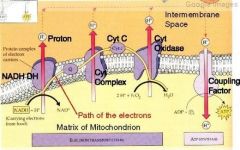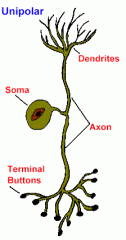![]()
![]()
![]()
Use LEFT and RIGHT arrow keys to navigate between flashcards;
Use UP and DOWN arrow keys to flip the card;
H to show hint;
A reads text to speech;
85 Cards in this Set
- Front
- Back
|
Energy |
-Ability to do work
|
|
|
Metabolism |
-Harvesting, making and using energy -A rate (Basal Metabolic Rate) generally measured as mL O2/hr) - Catabolism = breaking down
|
|
|
Anabolism |
-Biosynthesis
|
|
|
Catabolism |
-Breaking down complex molecules into simpler ones |
|
|
Laws of Thermodynamics |
All organisms exchange energy with their |
|
|
1st Law of Thermodynamics |
Energy cannot be created or destroyed, but can |
|
|
2nd Law of Thermodynamics |
- Energy transformations are never 100% efficient (eg, jogging, automobile) |
|
|
Aerobic Cellular Respiration |
C6H12O6 - Carbon dioxide and water are waste products
|
|
|
Reduced = gain e- |
None |
|
|
Glycolysis
|
In cytosol -Energy gain:
|
|
|
Citric Acid Cycle |
- In mitochondria
|
|
|
Electron Transport Train |

- In mitochondria *Electrons can be
|
|
|
ATP Synthase |
-Protein embedded in mitochondria membrane - Oxidative phosphorylation
|
|
|
Final total of our running tab… |
none |
|
|
Fermentation Anaerobic Cellular Respiration |
Generates ATP in absence of O2
|
|
|
Homeostasis |
Ability to maintain equilibrium within internal |
|
|
Thermoregulation |
-Maintaining body temperature in some optimal range |
|
|
Temperature is a measure of heat...and heat is energy |
none |
|
|
Heat Exchange |
-Successful thermoregulation must |
|
|
Conduction |
-Direct transfer of heat between a body and the |
|
|
Radiation |
-Transfer of heat between objects that are not in |
|
|
Convection |
- Transfer of heat by the movement of air past |
|
|
Evaporation |
- Loss of heat from a wet surface |
|
|
Thermoregulation |
-Metabolism requires specific |
|
|
Fat Soluble Vitamins |

|
|
|
Water Soluble |

|
|
|
Central Nervous System |
consists of the brain and spinal cord -it is responsible for integrating, processing, and coordinating sensory data and motor commands |
|
|
Peripheral Nervous System |
Includes all neural tissue outside the CNS |
|
|
Receptors |
Are sensory Structures that detect changes in the internal or external environment |
|
|
Sensory Division |
The sensory division of the PNS brings information from receptors to the CNS |
|
|
Motor Division |
Of the PNS carries motor command from the CNS to the effectors or target organs |
|
|
Nuerons |
Are Nerve cells specialized for intercellular communication -Neurons have three general regions: -Dendrites that receive stimuli -A cell body that contains the nucleus and other organelles -an axon thats carries information to other cells
|
|
|
Telodendria |
A main axon trunk end in a series of extensions--end at axon terminals |
|
|
Axon Terminals |
Or Synaptic terminals where the neuron communicates with other cells---Synapse |
|
|
Neurotransmitters |
Communication between a Presynaptic cell and a Postsynaptic cell most commonly involves the release of this chemical -Released to effect the membrane potential of another neuron More than 100 different neurotransmitters |
|
|
Anaxonic Neurons |
Are small and lack anatomical features that distinguish dendrites from axons--all cell processes look alike-are located in the brain and special sense organs |
|
|
Bipolar Neurons |

Have two distinct processes -One dendritic process that branches extensively at its distal tip and one axon-with the cell body between the two -Rare but appear in special sense organs-sight, smell and hearing -Are small |
|
|
Unipolar Neuron |

The dendrites and axon are continuous-basically fused and the cell body lies off to one side -Most sensory neurons in the PNS are unipolar |
|
|
Multipolar Neurons |
Have two or more dendrites and a single axon -These are the most common neurons in the CNS -All motor neuron that control skeletal muscles for example are multipolar neurons |
|
|
Sensory Neuron |
Are unipolar neurons whose bodies are in the PNS, form the afferent division of the PNS and deliver the information from sensory receptors to the CNS |
|
|
Interneuron |
Usually lie between sensory and motor neurons -Receive sensory information from the PNS as well as input from other interneurons in the CNS -Responsible for higher functions such as memory, planning and learning |
|
|
Motor Neurons |
Innervate the effector organ -Somatic-skeletal muscle fibers -Visceral-Smooth muscle, glands, cardiac muscle and adipose tissue |
|
|
Neuroglia or Glial Cells |
Support and protect neurons |
|
|
Ependymal Cells |
Are associated with cerebrospinal fluid production and circulation |
|
|
Microglia |
Remove cellular debris and pathogens |
|
|
Astrocytes |
Maintain the blood brain barrier that isolates the CNS from the chemicals and hormones circulating in the blood |
|
|
Oligodendrocytes |
Provide a structural framework within the CNS by stabilizing the positions of the axons -Produce myelin |
|
|
Myelin Sheath |
Surround axons making up white matter in CNS -Membraneous wrapping increases speed of nerve impulse transmission Myelin sheath is incomplete
|
|
|
Grey Matter |
Unmyelinated neuron cell bodies, dendrites and unmyelinated cell axons in CNS |
|
|
Schwann Cells |
form a myelin sheath around of enclose segments of axons in the PNS |
|
|
Satellite Cells |
surround cell bodies in ganglia in PNS |
|
|
Sensory Ganglia |
Or ganglion is a collection of Neuron cell bodies in PNS- |
|
|
Wallerian Degeneration |
Process that often fails to restore full function in repairs of nerves in PNS |
|
|
Membrane Potential |
Is the unequal charge distribution between the inner and outer surfaces of the plasma membrane where there is a slight negative charge inside the plasma membrane with respect to the outside. -Electrical potential
|
|
|
Resting Potential |
The membrane potential of an undisturbed cell -All neural activities begin with a change in the resting potential of a neuron - Many ions present |
|
|
Graded Potential |
A localized change, caused by a stimulus, in the resting potential. -This change, which decreases with distance away from the stimulus is the graded potential |
|
|
Action Potential |
If a graded potential is large, it will trigger an action potential in the excitable membrane of the axon. -it is an electrical event that involves one location on the membrane. -Once it develops in one location, it spreads along the surface of an axon toward the axon terminals Action potential
|
|
|
Synaptic Activity |
Produces graded potentials in the plasma membrane of the postsynaptic cell. Involves the release of neurotransmitters by the presynaptic cell and the compound bind to receptors on the postsynaptic plasma membrane changing is permability |
|
|
Information Processing |
The integration of stimuli at the level of the individual cell is the simplest form of info processing in the nervous system |
|
|
Gated Channels |
-change permeability in plasma membrane
|
|
|
Chemically Gated Channel |
Open when specific chemicals such as ACh bind to them |
|
|
Voltage Gated Channels |
Open or Close in response to changes in the membrane potential and are characteristic of excitable membranes |
|
|
Mechanically Gated Channels |
Open in response to physical distortion of the membrane surface--they are found in sensory receptors that respond to touch, vibration or pressure |
|
|
Depolarization |
Any shift from resting potential toward a more positive value |
|
|
Repolarization |
return to resting potential |
|
|
Hyperpolarization |
Shift in membrane potential more negative than negative potential |
|
|
Generating Signals |
Stimulus = Disturbance in resting membrane |
|
|
Transmitting Signals-short Distances |
Unmyelinated membranes |
|
|
Transmitting Long Distance Signals |
Myelinated membranes |
|
|
Saltatory Conduction |
Nodes of Ranvier
|
|
|
Acetylcholine |
One neurotransmitter secreted/used by both |
|
|
Noepinephrine |
Epinephrine – slightly different makeup, but same effect |
|
|
Cerebrum |
Largest part of brain |
|
|
Cerebellum |
Left and right hemispheres Spatial perception |
|
|
Brainstem |
Medulla oblongata
|
|
|
Spinal Cord |
Cervical nerves--thoracic nerves--lumbar nerves--sacral nerves---coccygeal nerves in that order from brainstem |
|
|
Somatic Nervous System |
Voluntary movement |
|
|
Autonomic Nervous System |
Self-governed Sympathetic nervous division |
|
|
Difference between the Two |
Somatic nervous system includes all of the neural pathways (neurons) that result in voluntary actions, basically anything that you can tell your brain to do like move your arm or stick out your tongue. The autonomic nervous system includes all of the neural pathways that result in involuntary actions, like your brain telling your eyes to blink or your intestines to contract, basically anything that you cannot control. |
|
|
Parasympathetic |
* The parasympathetic nervous system activates tranquil functions, such as stimulating the secretion of saliva or digestive enzymes into the stomach.
|
|
|
Sympathetic |
* The sympathetic nervous system is involved in the stimulation of activities that prepare the body for action, such as increasing the heart rate, increasing the release of sugar from the liver into the blood, and other generally considered as fight-or-flight responses (responses that serve to fight off or retreat from danger).
|
|
|
Sensory System |
A sensory system consists of:
|
|
|
Signal Reception |
Range from single cells to complex sense |
|
|
Chemoreceptor |
Use different types of chemoreceptors |
|
|
none |
none
|

